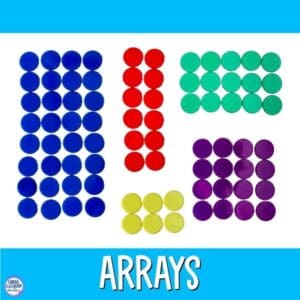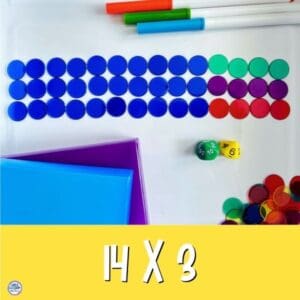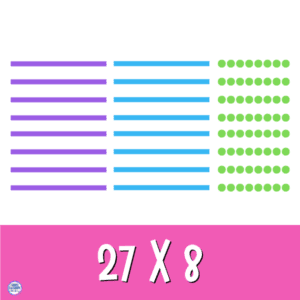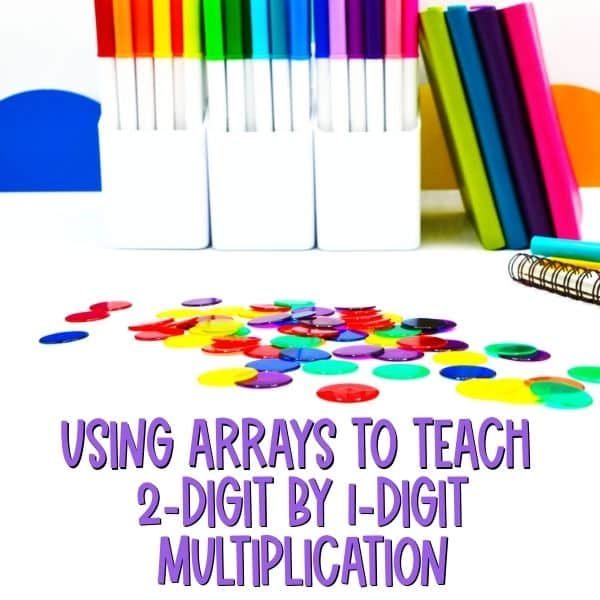Introducing area model multiplication? Take a deep breath, remind your students how smart they are, and use arrays to make the process more visual and understandable. Arrays help students grasp the concept of multiplication by showing them how groups of numbers add up to form a product. Let’s walk through a step-by-step guide to teaching 2-digit by 1-digit multiplication using arrays, based on this lesson plan and resources.
Step 1: Review the Concept of Arrays
Remind students what arrays are and how they relate to multiplication. An array is a visual representation of multiplication concepts, with rows and columns representing the factors in a multiplication problem. For example, to multiply 3 by 4, you can draw an array with 3 rows and 4 columns, which visually shows the total number of objects (3 rows of 4). You probably covered this concept in detail just few weeks ago, so surely they didn’t forget (wink-wink).
Remind students how arrays can be used to solve multiplication problems. Use simple, one-digit multiplication examples to bring this concept back to the surface for your kids. For instance, illustrate how 4 x 3 can be visualized as an array of 4 rows with 3 objects in each row. Emphasize that the total number of objects is the product of the multiplication problem.

Step 2: Expand Arrays to Include 2-Digit by 1-Digit Multiplication
Now, move on to 2-digit by 1-digit multiplication. Use the example of 14 x 3. Build the arrays for two-digit numbers by using one color to represent each group of 10.

Example:
- Build 14 by using one color for 10 and a different color for 4. This is a visual representation of 14 in expanded form.
- Add enough rows to the array to represent the multiplication problem. In this example we are multiplying by 3 so we need 3 rows of 14.
- Find the product of each part of the array:
- BLUE – 10 x 3 = 30
- MULTICOLOR – 4 x 3 = 12
- Add the two parts of the array (called partial products) to find the total product:
- 30 + 12 = 42
Step 3: Draw Arrays for 2-Digit by 1-Digit Multiplication
Using arrays for area model multiplication can get cumbersome once students start multiplying numbers larger than 20 so it’s time to transition away from using manipulatives and teach students how illustrate this process with hand-drawn arrays. Draw an array to represent each part of the multiplication problem. To make this process a little easier, show students how to use a bar to represent 10 and a dot to represent 1.

Example: 27 x 8
- Draw an array for 20 x 8:
- 8 rows of 2 tens = 160
- Draw an array for 7 x 8:
- 8 rows of 7 ones = 56
- Combine the arrays to show the total product of 216.
Step 4: Practice Area Model Multiplication with Different Problems
Provide students with a variety of 2-digit by 1-digit area model multiplication problems. Have them draw arrays to solve each problem, breaking down the 2-digit number into tens and ones, multiplying each by the 1-digit number, and then adding the partial products.
Example Problems:
- 14 x 2
- 23 x 4
- 36 x 5
To Make it Easy, Use a Done-for-you Resource
This resource includes detailed lesson plans, worksheets, and activities to reinforce the concept. These resources are designed to provide step-by-step instructions and a variety of fun ways to practice area model multiplication using arrays.
Resource Highlights:
- Worksheets for practicing area model multiplication with arrays.
- A mini-lesson for breaking down numbers and drawing arrays.
- Activities to reinforce the concept through hands-on practice such as an interactive notebook activity and a partner game
- Task cards for your favorite cooperative learning activities
Make it a whole unit with this 2-digit by 1-digit multiplication unit including 8 topics!
By following these steps, you’ll be able to introduce and teach 2-digit by 1-digit multiplication using arrays effectively. This visual approach not only makes multiplication more accessible but also enhances students’ overall mathematical understanding and sets them up for area model multiplication of even larger numbers!





